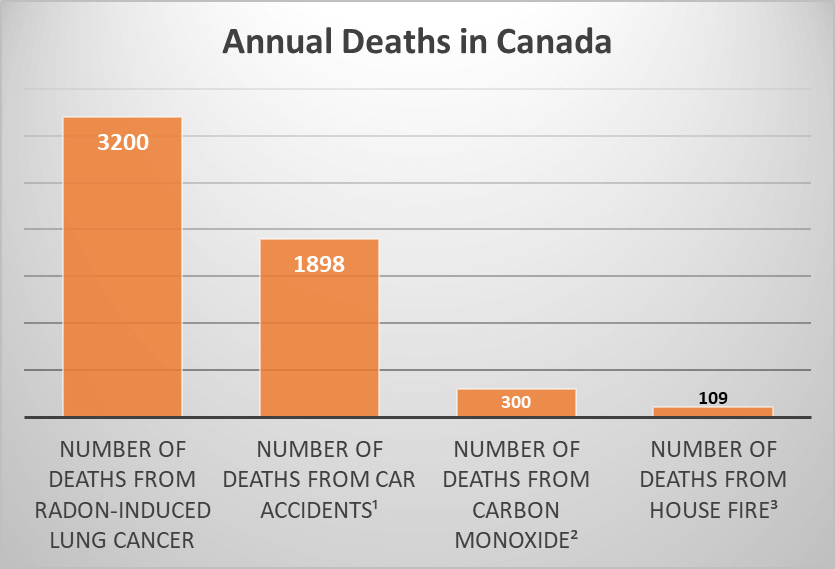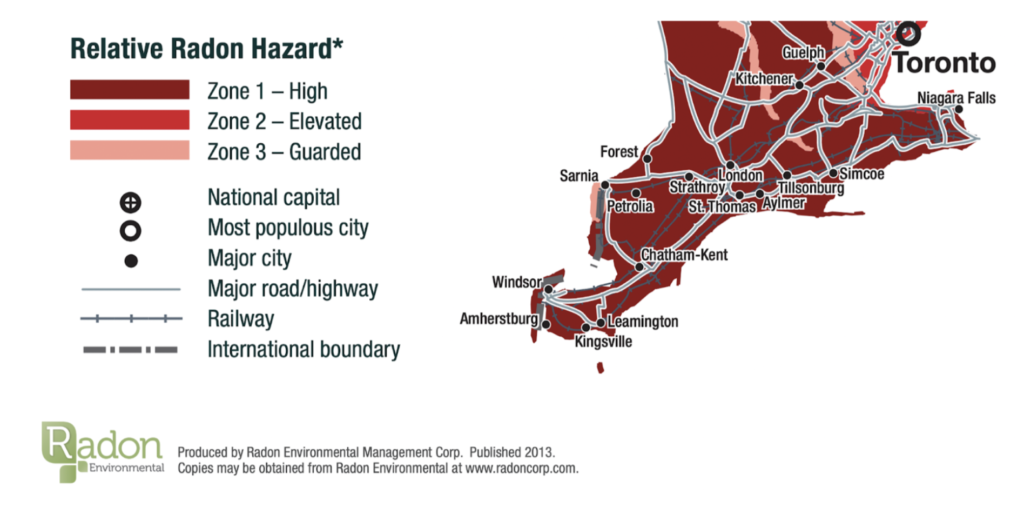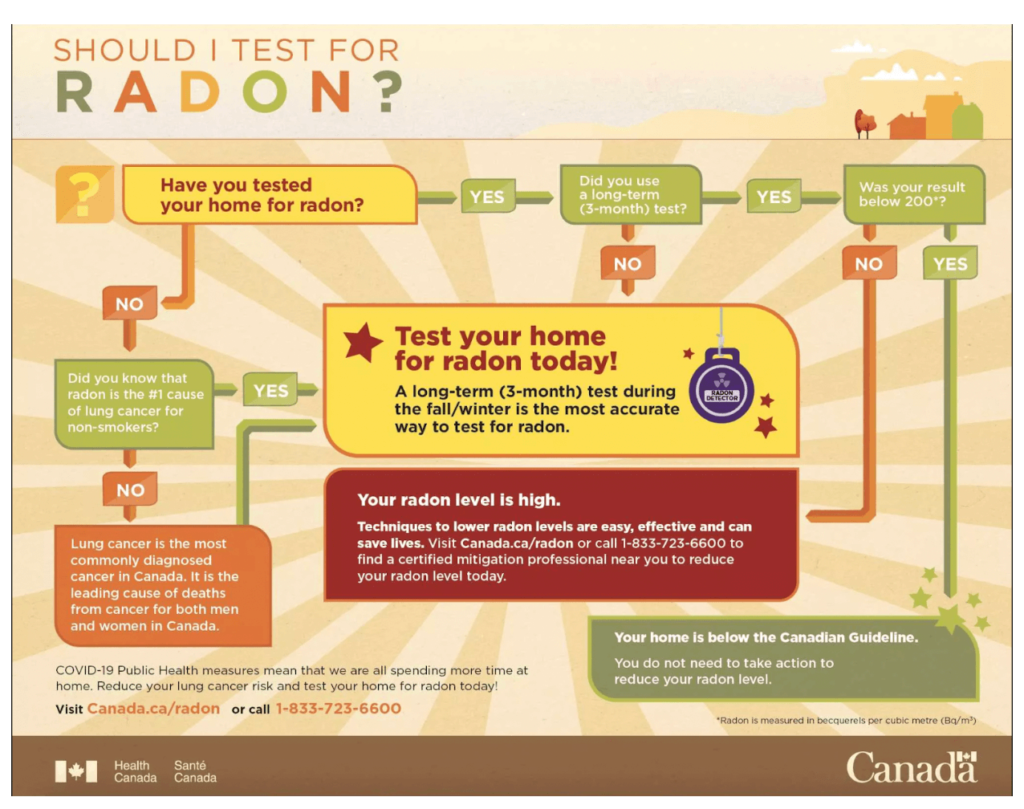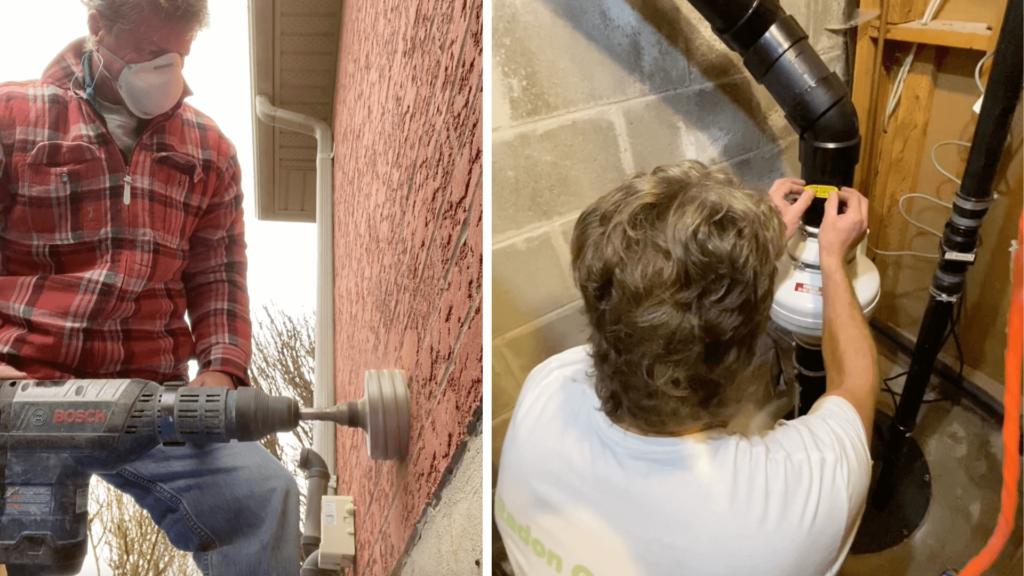What is Radon Gas?
Radon gas is a colourless, odourless, tasteless radioactive gas that is found in virtually all homes across Ontario and Canada. As more homeowners are learning about the risks associated with radon gas exposure, many are left wondering what exactly radon gas is, how to test for it and what to do if you have high levels of radon gas in your home. Continue reading to learn everything you need to know about radon gas, or contact Radon Gas Guys to get your home tested now.
Radon Gas – What Exactly Is Radon Gas?
Radon gas is a colourless, odourless and tasteless gas. Radon gas is radioactive, meaning it emits radiation into its surrounding environment. Radon gas occurs naturally in the earth and in the environment all around us. It is produced when uranium, a heavy metal found naturally in rocks and the earth’s crust, begins to decay.
Uranium undergoes a natural decaying process. As it decays, it releases the radioactive radon gas. Because uranium decays in the earth’s crust (underground), radon is emitted from the ground. The video below does a great job summarizing what radon gas is.
As radon is emitted from the ground, it can enter buildings and homes. The highest concentration of radon is usually found in basements, crawlspaces and lower levels of the home. However, any area of the home can be affected.
How Radon Gas Exposure Affects Your Health
Radon gas is everywhere. It is impossible to avoid it entirely. It naturally occurs in the environment–not only in the ground but also in the air and water. While there is no guaranteed safe level of radon gas exposure, the Canadian guideline for radon gas in the home is 200 Bq/m3.
So, what happens if you are exposed to radon gas? Unlike other indoor air pollutants and hazards like carbon monoxide, exposure to radon gas presents a risk over the long term.
When radon gas is found in high levels in your home you and your family members will breathe it in along with oxygen. When you breathe in this gas, it decays into radioactive particles while inside your lungs. Radioactive particles will then emit dangerous energy inside your lung and over time, will cause damage to lung tissue. If you continue to breathe in high levels of radon gas over many years, this exposure can significantly increase your risk of developing lung cancer.

How do I know if the levels in my home are elevated?
While some individuals experience symptoms as a result of exposure to radon gas, including (but not limited to) a cough, wheezing, shortness of breath, chest pain or loss of appetite, the only way to be sure if the levels in your home are elevated is to test.
To test your home for radon, you have the option of purchasing an at-home test kit or having a certified professional perform the test for you. For professional radon testing, click here.
Health Canada recommends that every homeowner tests their home for a minimum of 3 months, ideally when the indoor levels of radon are highest. Typically, this timeframe falls between October – April when windows are closed and rising air currents pull in more radon gas from the soil.
You have probably heard about the lung cancer risk associated with smoking–but did you know that radon gas is the number one cause of lung cancer in non-smoking individuals? Annually, radon gas exposure results in 3,200 deaths. To put that in perspective, car accidents result in approximately 1,900 deaths per year.
While radon gas is well known for its lung cancer risk, researchers are still learning more about exposure to this gas and the other health hazards it might present. In a recent 2024 study, researchers found an association between stroke risk and radon gas exposure.
The study found that high and even moderate exposure to radon gas was associated with a higher risk of a stroke in middle-age to older women. Although this study is new and and will be explored further to confirm the findings, it shows that we still do not know all of the potential health impacts of radon gas exposure and homeowners should do everything they can do reduce radon levels in their homes.
Symptoms of Radon Gas Exposure
Radon gas exposure causes long-term damage to the tissue in your lungs. It takes years of repeat exposure for this damage to result in an increased cancer risk. Radon gas is odourless, colourless and tasteless–there is no way of knowing that you have been exposed without a radon gas test. Unfortunately, the only symptoms associated with radon gas exposure are lung cancer symptoms.
Some common symptoms of lung cancer include:
- Difficulty breathing and shortness of breath
- New or worsening cough
- Hoarseness
- Pain or tightness in the chest
- Difficulty swallowing
- Coughing blood
If you or someone in your family has any of these symptoms, it is important to seek medical attention right away.
Although you won’t have any noticeable symptoms of radon gas exposure, poor indoor air quality can cause acute health symptoms. Radon gas can collect in poorly ventilated areas and poor ventilation can also contribute to poor indoor air quality.
Some common symptoms associated with poor indoor air quality include:
- Irritation of the eyes, nose and throat
- Coughing, increased asthma symptoms
- Headaches, dizziness and flu-like symptoms
- Fatigue
- Respiratory and heart diseases
If you notice symptoms like the ones above, you should also seek medication attention. You should also talk to a professional to conduct an air quality test and find out the root cause of the poor indoor air quality. It can be caused by several reasons such as mould growth, poor ventilation and plumbing, excess dust and pet hair or even fumes from appliances or indoor cooking.
Radon Gas In Ontario
Is radon gas found in Ontario? The short answer is yes. Radon gas is found everywhere because uranium is found in the earth’s crust. However, some areas have higher average levels of radon gas due to the surrounding environment. For example, certain rock, soil and even glacial components can contribute to higher or lower levels of radon gas.
Health Canada conducted Canada-wide surveys between 2009 and 2011 to discover and monitor the level of radon gas in the average home. This data was collected for cities across the nation. The map below shows the average level of radon gas found in Southern Ontario.

As you can see from the map above, the majority of Southern Ontario is listed as a “Zone 1 – High” region. This dark red area indicates that there is a higher likelihood a home in these regions will have elevated levels of radon gas in it. Other areas designed Zone 2 and Zone 3 are less likely to have elevated levels.
It is very important to note that this map cannot tell you for certain what your home’s radon level is. This just outlines the average risk for each city. Your home is unique. You can have low levels of radon in your home, while your neighbour conducts a test during the same time and discovers they have high levels of radon gas. There are so many factors that can increase or decrease your chances of having high levels of radon in your home, which we will go over in the section below.
How does radon gas enter the home?
Radon gas can enter your home in many different ways. If you live in a high-risk zone, the likelihood that these factors will result in high levels of radon gas increases. However, as we mentioned above, high levels of radon gas can be found in any home across Ontario and Canada.

Radon gas most often seeps into homes from the basement or another lower level in the home. Below are some of the most common issues that result in high levels of radon gas indoors:
- Cracks in your foundation floor
- Cracks in your foundational walls
- Poorly sealed windows or other openings
- Gaps around hydro entries or sump pumps
- Through floor drains
- Spaces or cavities inside walls
- Gaps around support posts or construction joints
Minor infrastructure problems and result in radon gas seeping into the home, however, even if you do not notice anything wrong with your foundation or see any obvious points of entry, you may still have high levels of radon gas. The only way to find out what your home’s radon gas levels are is to conduct a radon gas test.
How To Test For Radon Gas In Your Home
Learning about radon gas in your home can be overwhelming. The good news is that testing for radon gas is very simple! Most homeowners will opt for a dosimeter test. This small device is installed into the lowest level of your home (typically a basement) and left for at least 91 days. Why is it left for so long?
Radon gas levels will vary! One high reading doesn’t necessarily mean you have high levels of radon gas in your home–and the same goes for one low reading. It is important to find the average levels over a longer period of time to get the most accurate reading.

At Radon Gas Guys, we offer a wide variety of indoor air quality and radon gas testing. Take a look at some of the options below to learn more.
Comprehensive Test My Home Package
$425
Your one-stop shop for air quality testing! When you choose the Test My Home package, we will come to your home and test for both radon and mould. A radon test is conducted over the course of a few months to get the most accurate reading. Once complete, you will receive all your radon readings and a lab report for the mould results. If we find any problems, you’ll also receive a prescribed mitigation plan of action based on both reports.
$55 (refunded if Radon Gas Guys provide the mitigation system if needed)
Radon dosimeters are cost-effective and easy to use, making it a simple solution to find out if your home has excess levels of radon gas. Installed in the lowest level of your home or building, the dosimeter records an average radon level over a 3-12 month period, as outlined by Health Canada. Following the minimum 91-day test, homeowners must then send the results to a lab for analysis and results.
For more information and options for radon testing, click here.
Radon Gas Mitigation – Removing Radon Gas From Your Home
After you have conducted a radon gas test, you will find out what the average level of radon gas is in your home. If your levels are high, it is time to contact the professionals and get a radon gas mitigation system installed!
Installing a “mitigation system” might sound like a complicated process, but it is actually fairly simple. The process usually only takes one day and won’t cause any major disturbances to the rest of your family or your home. So, how does it work?
First, Radon Gas Guys will inspect your home to check for any issues that may be allowing excess radon to seep in. We believe in permanent, long-term solutions so we will seal areas around windows and sump pumps or hydro entries, fix minor cracks and seal gaps or spaces between walls if needed.

Once we have found and resolved any issues that could result in high levels of radon gas, our experienced team will install the radon mitigation system. This system is typically installed in your basement but may be installed on a different floor based on your home’s layout.
The system installed is quite simple. It is essentially made of a pipe and fan. This system will be installed into the foundation of your home and removes radon gas by sucking it out from your indoor space (through the pipe) and exhausting it outdoors (with the fan).
For new homeowners, your radon gas mitigation system might actually be covered by your new home warranty. if your home is less than 7 years old, radon gas mitigation systems are covered by Tarion Warranty. If you have recently moved into a brand new home or have purchased a home that is less than 7 years old, you should conduct a radon test right away. This will help to ensure that your mitigation system is covered under warranty if any issues with radon gas are detected.
Worried About Radon Gas In Your Home? Trust Radon Gas Guys For Radon Gas Testing and Removal
Many homeowners are just recently learning about radon gas–and we understand that can feel overwhelming. As a homeowner, we know that you want to keep your home and family safe from hazards. When you choose to work with Radon Gas Guys, you will be working with a professional company that cares about homeowners all across Southern Ontario. We are committed to keeping you and your family safe.
We have a record of excellence and ensure all of our staff are fully trained to handle all mitigation jobs. We also have a 100% guarantee that our radon mitigation systems will work. If the radon mitigation system does not reduce the levels below the Canadian standard, we always fix it at no cost to you or refund your money. We guarantee it! We always stand by our work.
If you are worried about high levels of radon gas in your home in Hamilton and are ready for radon gas removal, give us a call. We are happy to talk with you to discuss all of your mitigation options.
